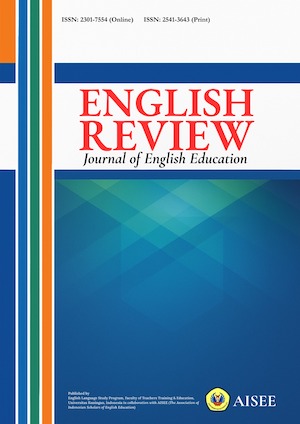INVESTIGATING ENGLISH LANGUAGE EDUCATION STUDENTS’ READING PREFERENCES
Abstract
This study aimed to determine students' preferences for their reading materials and dig out the benefits of their reading preferences. A descriptive research design was applied in this study. Two instruments were employed to obtain the data, namely a questionnaire and an interview guide. The subjects of this study were 35 third semester students of the English Language Education Department. These participants were selected by using a simple random sampling technique. In the data collection procedure, the participants filled in the questionnaire. Then, three of the participants were selected further to be interviewed. The data were then analyzed by calculating each item in the survey to obtain the final result in the form of a percentage, transcribing, and examining the interview result. The findings found that most of the students preferred novels as their reading material with 54,2%. Furthermore, as many as 31,4% preferred the genre of fiction. Several benefits from having their own preference in reading constitute (1) the students were able to comprehend the content of the reading material easily, (2) the students got more interested in reading, (3) the students gained broader knowledge, and (4) the students got attached to and focused on the text. Overall, this study implies that English language education students preferred novels as their reading material and fiction as their favored genre. These findings also signified that the students could gain many benefits from their preferences.References
Aharony, N., & Bar-Ilan, J. (2018). Students’ academic reading preferences: An exploratory study.” Journal of Librarianship and Information Science 50(1), p.3–13.
Alshammari, M. M. (2015). New developments in teaching reading comprehension skills to EFL learners. International Journal of English Language Teaching, 3(1), p.1–10.
Arias, I. J. (2007). Selecting reading materials wisely. Letras, 41, p.131–151.
Arthi, M., & Srinivasan, R. (2018). Influence of reading comprehension strategies on English language teaching at the tertiary level. Bodhi International Journal of Research in Humanities, Arts and Science, 2(3), p.2–4.
Aydın, G., & Bağcı, A. B. (2018). Reading preferences of middle school students. World Journal of Education, 8(2), 127. https://doi.org/10.5430/wje.v8n2p127
Blau, H., & Baker, W. D. (2006). Reading skills. The English Journal, 49(9), p.657. https://doi.org/10.2307/810505
Bouchamma, Y., Poulin, V., Basque, M., & Ruel, C. (2013). Impact of students’ reading preferences on reading achievement. Creative Education, 04(08), p.484–491. https://doi.org/10.4236/ce.2013.48070
Celik, B. (2017). Effects of extensive reading on learners: How it develops certain points in vocabulary and sentence structure. International Journal of English Linguistics, 8(2), 73. https://doi.org/10.5539/ijel.v8n2p73
Erfanpour, M. A. (2013). The effect of intensive and extensive reading strategies on reading comprehension: A case of iranian high school students. 14(41).
Eutsler, L., & Trotter, J. (2020). Print or iPad? Young children’s text type shared reading preference and behaviors in comparison to parent predictions and at-home practices. Literacy Research and Instruction, (00), p.1–22. https://doi.org/10.1080/19388071.2020.1777229.
Gilakjani, A. P. (2017). How can students improve their reading comprehension skill ? https://doi.org/10.5296/jse.v6i2.9201.
Hussain, I., & Munshi, P. (2011). Identifying reading preferences of secondary school students. Creative Education, 02(05), p.429–434. https://doi.org/10.4236/ce.2011.25062.
Jacobs, G. M. (2014). Selecting extensive reading materials. Beyond Words, 2(1), p.112–127.
Lestari, W. A. (2018). The difference between male and female students’ preference on types of reading text at university of muhammadiyah malang. Malang: UMM
Shonfeld, M. & Meishar-Tal, H. (2016). Writing and reading preferences for student learning in a paperless classroom. In G. Chamblee & L. Langub (Eds.). Proceedings of Society for Information Technology & Teacher Education International Conference (p. 787-792). Savannah, GA, United States: Association for the Advancement of Computing in Education
(AACE). Retrieved July 9, 2020 from https://www.learntechlib.org/primary/p/171772/.
Tsai, C. H. (2012). Students’ perceptions of using a novel as main material in the EFL reading course. English Language Teaching, 5(8), p.103–112.
https://doi.org/10.5539/elt.v5n8p103
Tuğrul, M. C. (2015). Combining extensive and intensive reading to reinforce language learning. Journal of Educational and Instructional Studies Inthe World, 5(4), p.85–90. Retrieved from http://www.wjeis.org/FileUpload/ds217232/File/09a.mart.pdf
Zare, P., & Othman, M. (2013). The relationship between reading comprehension and reading strategy use among Malaysian ESL learners. 3(13), p.187–193.
All articles published in English Review: Journal of English Education (ERJEE) are licensed under the Creative Commons Attribution 4.0 International License (CC BY 4.0).
Copyright Ownership
Authors retain the copyright of their articles and grant ERJEE the right of first publication. The journal is granted a non-exclusive license to publish, reproduce, and distribute the article in any format, medium, or platform, provided that proper credit is given to the original authors.
License Terms – CC BY 4.0
Under the Creative Commons Attribution 4.0 International License, others are free to:
- Share — copy and redistribute the material in any medium or format
- Adapt — remix, transform, and build upon the material for any purpose, even commercially
As long as they:
- Provide appropriate credit to the original author(s) and source
- Provide a link to the license (https://creativecommons.org/licenses/by/4.0/)
- Indicate if any changes were made
There are no restrictions on the reuse, reproduction, or adaptation of published articles as long as attribution is properly given.
Author Warranties
By submitting a manuscript to ERJEE, authors confirm that:
- The work is original and does not infringe any existing copyright.
- The manuscript has not been previously published and is not under consideration elsewhere.
- All sources and references are appropriately acknowledged.
- Necessary permissions have been obtained for any copyrighted materials used.









